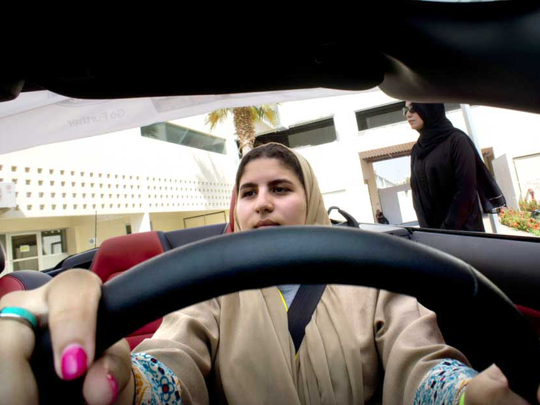
Jeddah: Fatima Salem giggles with hesitation when it’s her turn to drive through a small parking lot lined with bright orange cones and arrows.
Like millions of Saudi women, she plans on applying for a driver’s license when the kingdom lifts its ban on women driving in June. But first, she has to learn how to drive.
“I’m a little nervous,” the 30-year-old master’s student said.
Francesca Pardini, an Italian former racecar driver, helps calm her nerves, reminding Salem to check the mirrors and buckle up.
Once on the road, Pardini reached over to help straighten out the wheel after a left turn, and they both lurched forward when Salem stepped on the brakes before a stop sign.
A royal decree issued last year by King Salman announcing that women would be allowed to drive in 2018 upended an unofficial ban on women driving.
Crown Prince Mohammad Bin Salman, has pushed through a number of other reforms to relax some of the country’s ultraconservative rules, including allowing women into stadiums to watch sports, bringing back musical concerts and promising a return of movie theaters this month after a more than three-decade ban.
The reforms are aimed at improving Saudi Arabia’s image abroad, attracting foreign investors, increasing women’s participation in the workforce and boosting local household spending as lower oil prices force the kingdom to undertake sensitive austerity measures.
The ban on women driving has been costly for Saudi families. The wealthy hire and house male drivers, often from South Asian countries, while others make due with taxis and ride-hailing services.
Still, for many women, commuting to work or running basic errands requires a husband or son who can make the drive.
At the female-only campus of Effat University in Jeddah, dozens of young Saudi students dressed in long, loose black robes braved the afternoon heat for a chance to learn how to drive on their own.
The university organised training this week for students to learn the basics of how to operate a car. For most of the young women, the hour-long training, sponsored by Ford Motor, is the first time they’ve ever sat in the driver’s seat. Female-only universities across Saudi Arabia are expected to offer women full driving courses once the rules and guidelines from the government are announced.
“I felt out of place. I’ve never sat on that side of the car. Usually I always sit in the back or on the right side, but it felt good. You feel, like, in control,” said Sara Ghouth, an 18-year-old freshman.
“I want to drive a car. I want to be independent.”
Car companies see the lifting of the ban as an opportunity to promote their brands and rev up sales in Saudi Arabia, a country of around 20 million citizens where around half are women.
Ford’s Driving Skills for Life programme, a one-time session that focuses on safety, has been taught around the world, including to male drivers in Saudi Arabia, but this is the first time the company has taught women-only groups, which are mostly made up of first-time drivers.
“With these girls, they’re like an empty book,” said Pardini, the Italian trainer with Ford. “They really want to learn.”
Before the training began this week, Ford conducted surveys with women across Saudi Arabia to better understand what they are looking for in a car and how to market their brand to the new drivers.
“The first thing we don’t want to do is be patronising. This isn’t about lip gloss and nail polish and things like that. These are educated women,” said Crystal Worthem, a marketing manager with Ford.
Worthem said the American automaker “absolutely” expects a lift in sales as Saudi women start driving this summer.
She says some women are already purchasing cars for when the ban is lifted, while others own the cars they are ferried around in.
“Women have always been in our showrooms, but now women are actively shopping for themselves, which is exciting,” she said.
“It’s a car that they can drive and not a car that they’ll be riding in.”
Amal Al Jihani, a 23-year-old architecture student, said her biggest supporter encouraging her to drive is her father, who’s promised to give her one of the family’s used cars when she’s ready for the road. Her 16-year-old brother already drives.
“My mom is refusing the idea of us driving. She says it’s dangerous and she’ll let us drive when we’re married,” Al Jihani said, laughing.
“My dad tells her you’ll relax when you see everyone else driving.”
Joanna Al Fattani, a 19-year-old freshman, relies on ride-hailing services like Uber to go most places. To get to and from college, she has two different drivers. She said a lot of women are nervous about the idea of driving alongside men on the roads, but she’s looking forward to it.
“It’s such an important announcement. Everybody needed this. Now is the right time to do it,” she said.












